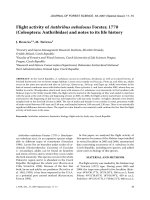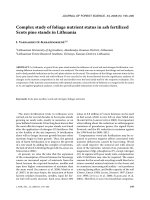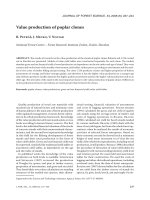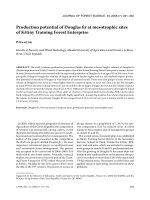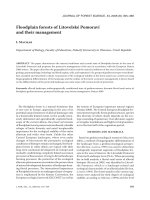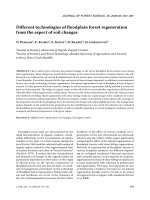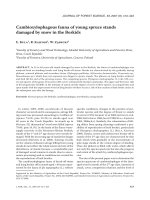Báo cáo lâm nghiệp: "Effect of an oil heat treatment on the leachability and biological resistance of boric acid impregnated wood" pps
Bạn đang xem bản rút gọn của tài liệu. Xem và tải ngay bản đầy đủ của tài liệu tại đây (409.75 KB, 6 trang )
Ann. For. Sci. 64 (2007) 673–678 Available online at:
c
INRA, EDP Sciences, 2007 www.afs-journal.org
DOI: 10.1051/forest:2007046
Original article
Effect of an oil heat treatment on the leachability and biological
resistance of boric acid impregnated wood*
Florent Lyon
a
**
, Marie-France T
hevenon
b
, Won-Joung Hwa n g
c
,YujiImamura
c
,JosephGril
a
,
Antonio
Pizzi
d
a
Laboratory of mechanics and civil engineering, University of Montpellier 2, CC 048 Pl. E. Bataillon, 34095 Montpellier Cedex 5, France
b
Wood preservation laboratory, CIRAD-Persyst UPR 40, TA 10/16, 34398 Montpellier Cedex 5, France
c
Research Institute of Sustainable Humanosphere, Kyoto University, Kyoto 611-0011, Japan
d
ENSTIB-LERMAB (Research and study laboratory on wood material), University of Nancy 1, 88051 Epinal Cedex 9, France
(Received 6 December 2006; accepted 26 January 2007)
Abstract – Vegetable oils provide boron retention of about 30% of initial amount depending on oil drying properties. Linseed oil is the most efficient,
followed by soybean oil and rapeseed oil. Durability of C. japonica and F. crenata wood specimens has been enhanced by application of linseed oil
alone but not enough to reduce termite’s attack of Coptotermes formosanus. Treating wood with a 1.0% w/w boric acid solution prior to oil treatment
protects C. japonica from termite and fungi degradations. Efficiency against termites is mainly due to boron retention by oil but hydrophobic oil also
forms a barrier decreasing fungi penetration. Boron efficacy threshold around 0.7 kg/m
3
BAE, lower than classical boron treatments thresholds indicates
that oil water-repellence reinforces boron biostatic effect.
boric acid / vegetable oil / wood preservation / termite test / fungi test
Résumé – Impact d’un traitement oléothermique sur la durabilité du bois imprégné à l’acide borique. La recherche en préservation du bois
se tourne à présent vers des produits à faibles impacts environnementaux. Nous avons étudié l’opportunité d’associer borates et huiles végétales pour
accroître la rétention du bore ainsi que la résistance du bois aux termites et aux champignons xylophages. Les huiles végétales permettent de retenir
environ 30 % du bore initial selon leurs propriétés de séchage. Ainsi, l’huile de lin est plus efficace que les huiles de soja et de colza. La durabilité
d’éprouvettes d’aubier de C. japonica et F. crenata est améliorée par l’ajout d’huile de lin mais trop peu pour éviter les attaques de termites Coptotermes
formosanus. En revanche, la combinaison d’une imprégnation par une solution d’acide borique à 1.0 % m/m suivi d’une traitement à l’huile protège
efficacement C. japonica contre les termites et les champignons. Alors que son efficacité contre les termites semble principalement due à la rétention du
bore, l’huile semble former une barrière efficace contre la pénétration des champignons xylophages. Les seuils d’efficacité d’environ 0.7 kg/m
3
BAE,
plus faible que ceux enregistrés pour les traitements classiques au bore indique que l’huile renforce l’effet biostatique du bore.
acide borique / huiles végétales / préservation / résistance aux termites / résistance aux champignons
1. INTRODUCTION
Because of environmental care, utilization of traditional
preservatives like CCA for all applications is now discussed.
Preservation policies are now directed towards fit-for-purpose
to provide a preservative adapted to each situation of wood
exposure [30]. For those reasons, boron-based preservatives
are considered as a good alternative regarding their low mam-
malian toxicity [7, 8, 13, 29, 33]. Boron compounds have a
broad spectrum effectiveness against wood degrading organ-
isms like fungi and termites as well as a low environmental
impact [1,28]. However borates can easily be leached out from
wood under outdoor exposure conditions because of their high
solubility into water [3, 10, 21].
* Tables I to III are only available in electronic form at
.
** Corresponding author:
To reduce boron leaching different strategies are reported
in literature like utilization of borates under low moisture con-
dition, chemical combination to produce less leachable com-
pounds like proteins [31], complex with tannins [24], ester bo-
rates [17] or amine [9, 20]. Addition of hydrophobic agents
or coating like varnish or paint has also been considered with
various efficiency depending on coating permeability [20].
Most authors consider that boron retention efficiency of such
combinations is around 15 to 50% of initial boron retained
[16, 17,20].
We observe since a few years an increasing interest in
the wood treatment involving vegetable oil [14, 15, 18] or
natural-oils derived of fatty acids [12,22, 23]. Following Rapp
(2001) [25] this technique will be named here “oil heat treat-
ment” Water repellence provided by hydrophobic oil reduces
wood equilibrium moisture content and leaching of extractives
like tannins, thus decreasing insects attacks and fungi decay
[34]. This type of treatment also provides a good dimensional
Article published by EDP Sciences and available at or />674 F. Lyon et al.
stability [25–27] and when it is performed on green wood, al-
lows to dry the wood with less peripheric cracking compared
to air-drying [2,4]. However oil-heat treatments are sometimes
inefficient to prevent insect attacks and fungi decay, especially
for sapstain and mold fungi because of their non toxicity to
those organisms [19].
This paper deals with the possibility of combining a boron
impregnation and an oil-heat treatment to improve wood dura-
bility. Three vegetable oils varying by their drying properties
and therefore permeability of their dry film are compared as
boron retention agent. The impact of these combinations is
evaluated for boron retention and biological resistance to ter-
mites and decay fungi.
2. MATERIALS AND METHODS
2.1. Wood material and chemicals
Sapwood specimens of Japanese cedar (Cryptomeria japonica
D. Don) and beech (Fagus crenata Blume), have been prepared for
vacuum-pressure impregnation using the following dimensions:
– Retention test: 50 (L) × 25 (T ) × 15 (R)mm
– Termites test: 20 (L) × 10 (T ) × 10 (R)mm
– Fungi test: 40 (L) × 20 (T ) × 5(R)mm
Those sizes based on Japanese Industrial Standard (JIS) for leach-
ing, decay and termite tests are usually recommended for surface
treatment. As our treatment combines both impregnation and surface
treatments, we have decided to use surface-test samples and submit
them to leaching procedure made for impregnation treatment. Thus
specimens were oven-dried at 60
◦
C for 72 h and then weighted be-
fore being treated by a 30-min vacuum treatment at 88 kpa absolute
pressure with boric acid aqueous solutions of 0.5, 1.0, 2.0 or 5.0%
w/w. Specimens were then weighted in their saturated state to deter-
mine the boric acid uptake (kg/m
3
boric acid equivalent. cf. formula
below) and then reconditioned at 20
◦
C and 50% relative humidity
during two weeks until stabilisation.
BA = (W
imp
− W
0
) ×
%
sol
V
BA: boric acid uptake (kg/m
3
BAE) W
imp
: impregnated weight (kg)
W
0
: oven dried weight (kg) %
sol
:%H
3
BO
3
of treatment solution w/w
V: sample volume (m
3
).
Before being submitted to an oil-heat treatment, the transverse
sections of the specimens were coated with epoxy resin to forbid ex-
changes in longitudinal direction as we want to study radial and tan-
gential retention. Moreover, we know that longitudinal exchanges are
usually blocked by a three centimetres oil layer. Thus treatment result
is application of an oil layer of about 1.5 mm thick on tangential and
radial surfaces. Inner part of wood pieces is free from oil.
Oil heat treatment consisted in a double dipping of one hour each;
first in a hot bath at 130
◦
C and second in a cold bath at 80
◦
C. Rape-
seed oil, soybean oil and linseed oil were used as treatment oil sep-
arately. Linseed oil is considered as a drying oil due to its high con-
tent in polyunsaturated fatty acids like linolenic acid (45 to 70%) and
linoleïc acid (12 to 24%) or monounsaturated acid like oleic acid (10
to 21%). Soybean oil is a semi-drying oil presenting a lower unsat-
uration degree compared to linseed oil because of its lower content
in polyunsaturated fatty acids (40 to 50%). Rapeseed oil is the less
drying oil with about 60% of oleic acid and 15% of saturated fatty
acids. Impact of these drying properties has been investigated regard-
ing boron retention and biological resistance of wood to degradation
organisms.
2.2. Leaching procedure
Leaching procedure was conducted according to the Japanese in-
dustrial Standard (JIS) K 1571 (JIS 2004) [35] for impregnation treat-
ment to reproduce the effect of weathering. This procedure involves a
cycle of immersion-drying during ten days. Specimens were soaked
in distilled water (10 vol. water for 1 vol. wood) at 27
◦
C under mag-
netic stirring at 400-500 rpm for 8 h and then oven dried at 60
◦
C
for 16 h. Leaching water is replaced after keeping a sample for boron
concentration analysis and this procedure is repeated ten times.
As boron is the preservative element of the mix, we followed the
amount of leached boron along the leaching procedure by using In-
ductively Coupled Plasma analysis (ICP) of leachates, leached and
unleached samples. Analyses of boron amount remaining before and
after leaching were realized after specimen’s extraction in hot water
at 80
◦
C during 2 h.
2.3. Termite test
Untreated control, leached and unleached wood specimens were
exposed to subterranean termites (Coptotermes formosanus Shiraki)
in a no-choice feeding test according to the Japan Industrial Standard
(JIS) K 1571 (2004) [35]. Specimens were placed at the bottom of an
acrylic cylindrical container (8 cm diameter and 6 cm high) blocked
at one end with dental plastone to form a strong 5 mm barrier. Acrylic
containers were then placed in larges plastics boxes papered with hu-
mid cotton pieces and sealed to keep high moisture conditions for
testing. One hundred fifty termite workers and fifteen soldiers were
collected and placed with each specimen. The full system was kept at
28
◦
C and 85% RH for three weeks. Termite mortality was recorded
every week and mass losses due to termite attack were calculated by
weighting for each specimen after three weeks of exposure.
2.4. Decay test
Specimens were exposed in monocultural fungi test performed ac-
cording to Japan Industrial Standard (JIS) K 1571 (2004) [35] using
a brown-rot fungus Fomitopsis palustris (Berkeley et Curtis) Murrill
(FFPRI 0507) and a white-rot fungus Trametes versicolor (L. ex Fr.)
Quel. (FFPRI 1030). Liquid fungal culture have been prepared by in-
oculation of a solution containing 40 g of glucose, 3 g of peptone,
15 g of malt extract and 1 000 mL of distilled water. Those cultures
were then shaken at 26
◦
C for 10 days at 100 rpm.
Glass jars containing 250 g of quartz sand were wetted with nu-
triment aqueous solution as follow and then sterilized by autoclave:
for White rot fungi, 85 mL of a solution containing 40 g of glucose,
3 g of peptone, 15 g of malt extract and 1 000 mL of distilled water;
for Brown rot fungi: 80 mL of a solution containing 20 g of glucose,
1.5 g of peptone, 7.5 g of malt extract and 1 000 mL of distilled water.
After inoculating glass jars with fungal cultures and waiting
10 days, three samples of the same condition sterilized using gaseous
Durability of boric acid/oil treated wood 675
0
10
20
30
40
50
60
70
80
Control
Linseed
oil
Soybean
oil
Rapeseed
oil
% of initial boron retained
after leaching
Figure 1. Boron retention after leaching provided by addition of lin-
seed, soybean or rapeseed oil in C. japonica specimens treated with
boric acid solution of 0.5
,1.0 ,2.0 or 5.0 % w/w .
(cf. Tab. I at www.afs-journal.org).
ethylene oxide were placed in each jar. Tests jars were finally incu-
bated at 26
◦
C for 12 weeks. Mass loss of specimens was calculated
as the difference of final and initial oven-dried weight of each sample.
3. RESULTS AND DISCUSSION
3.1. Retention results
Oil penetration depth has been evaluated around 1.5 mm.
Considering this depth, oil retention provided by this treatment
is about 140 to 160 kg/m
3
into the first millimetre from the
surface. Figure 1 indicates that vegetable oils increase boron
retention in wood of about 25 to 40% depending on the type
of oil. Linseed and soybean oils are more efficient to prevent
boron leaching than rapeseed oil. This fact may probably be
explained by oil composition and especially their insaturation
degree expressed through the iodine value (IV) which is the
iodine quantity fixed on 1g of fat. The higher this iodine value,
the higher the insaturation degree. When insaturation degree
is high like for linseed oil (IV = 186), drying process is fast
and fully completed to form a surface layer. When insaturation
degree is low like for rapeseed oil (IV = 105), drying process
is slow and the layer formed is less impermeable than in the
case of linseed oil. Soybean oil (IV = 138) has an intermediate
behaviour regarding drying and consequently regarding boron
leaching.
Except a small increase of retention for wood treated with
a 1.0% boric acid solution, boron concentration has no im-
pact on amount of boron leached (Tab. I, available online at
www.afs-journal.org).
3.2. Termite resistance
Mass losses after a three-weeks exposure to Coptotermes
formosanus termites are indicated in Figure 2. Control sam-
ples have lost about 26% or their initial weight for C. Japon-
ica and 13% for F. crenata. Results for both species indicate
that the combination of boric acid and vegetable oil is the only
solution to reach a durable state. Indeed we know that a treat-
ment involving only boron could not protect wood because of
leaching and results in Figure 2 show that application of veg-
etable oil alone reduces about half of mass losses in unleached
state but just a few percent after leaching. An unexpected re-
sult occurs for rapeseed oil which seems to be a bit efficient in
both leached and unleached states.
Boron retention around 30% of initial level for C. japon-
ica and 20% for F. crenata provided by addition of vegetable
oil makes the wood able to resist to termite attack when boric
acid solution concentration is high enough. Resistance for both
species is provided by application a boric acid solution of
1.0% w/w followed by an oil heat treatment. Retention level
recorded after leaching and efficient against termites is around
1.8 kg/m
3
BAE for F. crenata and C. japonica. Determina-
tion of this efficiency threshold is based on specimen mass
loss which have to be lower than 3% compared to initial mass.
This result a bit low but close to the bibliographic threshold for
boric acid indicates a reduced impact of borate and vegetable
oil combination regarding wood durability to termites. Effi-
ciency is mainly due to boron retention by vegetable oil appli-
cation and termite mortality is confirming this tendency even if
for 0.5% boric acid / oil-treated C. japonica samples, low mor-
tality percents compared to boron amount indicate a lack of
accessibility of boron or weak termite attack due to oily aspect
of wood (Tab. II, available online at www.afs-journal.org).
3.3. Decay resistance
Masses losses of C. japonica and F. crenata sapwood spec-
imens after a 12-weeks exposure to white-rot fungus Trametes
versicolor and brown-rot fungus Fomitopsis palustris are indi-
cated in Figures 3 and 4 respectively.
The three vegetable oils seem efficient when used alone
against Trametes versicolor on C. japonica. In the case of
F. crenata, they reduce mass losses by about 80% compared
to control sample but this improvement is not sufficient with
about 8% of mass loss left (Tab. III, available online at
www.afs-journal.org).
Addition of boric acid is then useless for C. japonica but
becomes unavoidable for F. crenata and treating wood with a
1.0% w/w boric acid solution for F. crenata prior to oil treat-
ment with one of the three oils reduces mass losses to reach
durable state with less than 3% of mass loss after 12 weeks
of exposure. Mass losses are following boric acid amount re-
maining in wood, consequently linseed oil provides a better
protection than soybean oil. Rapeseed oil is the less efficient.
Results for Fomitopsis palustris are more complex than for
Trametes versicolor. When used alone, vegetable oil provides
a “pass or fail” behaviour to wood pieces. A number of sam-
ples can be considered as durable when others are highly non
durable. This behaviour seems correlated with drying proper-
ties of oil.
In unleached state, 100% of C. japonica samples dipped in
linseed oil are durable when only 55 % and 45% for soybean
and rapeseed oil respectively. These percentages decrease with
676 F. Lyon et al.
0
5
10
15
20
25
30
Control
H
3
BO
3
0,25 %
H
3
BO
3
0,5 %
H
3
BO
3
1,0 %
% of mass loss
(A)
0
2
4
6
8
10
12
14
16
Control H
3
BO
3
H
3
BO
3
H
3
BO
3
% of mass loss
1,0 %
(E)
0,25 % 0,5 %
0
5
10
15
20
25
30
Control
H
3
BO
3
H
3
BO
3
Oil only
% of mass loss
H
3
BO
3
(B)
0,5 % 1,0 % 0,25 %
0
2
4
6
8
10
12
14
16
Control
H
3
BO
3
H
3
BO
3
0,5 %
H
3
BO
3
Oil only
% of mass loss
(F)
0,25 % 1,0 %
0
5
10
15
20
25
30
Oil only
Control
% of mass loss
0,5 %
H
3
BO
3
0,25 %
H
3
BO
3
H
3
BO
3
1,0 %
(C)
0
2
4
6
8
10
12
14
16
Control
0,25 % 0,5 %
H
3
BO
3
1,0 %
Oil only
% of mass loss
H
3
BO
3
H
3
BO
3
(G)
0
5
10
15
20
25
30
Control
% of mass loss
Oil only
0,5 % 1,0 %
H
3
BO
3
0,25 %
H
3
BO
3
H
3
BO
3
(D)
0
2
4
6
8
10
12
14
16
Control
0,25 % 0,5 %
H
3
BO
3
1,0 %
Oil only
% of mass loss
H
3
BO
3
H
3
BO
3
(H)
Figure 2. Mass losses of C. japonica (A,B,C,
D) and F.crenata (E, F, G, H) sapwood specimens
treated with combinations of boric acid in differ-
ent amount alone (A,E) or combined with linseed
oil (B, F), soybean oil (C, G) or rapeseed oil (D,
H) exposed to termites Coptotermes formosanus
in a three-weeks no-choice feeding test according
to Japanese industrial standard (JIS) K 1571 (JIS
2004). Mass losses of control
, unleached
and leached samples after exposure (cf. Tab. II
at www.afs-journal.org).
leaching. Indeed, 66%, 22% and no samples are considered as
durable after leaching for linseed, soybean and rapeseed oil re-
spectively. In those cases, non durable samples reach the high-
est mass losses directly, indicating that oil probably acts as a
barrier against fungi penetration. Efficiency of this barrier is
then logically depending on oil drying properties. In the case
of F. crenata samples, linseed oil alone seems able to provide
durable sample. Soybean and rapeseed-oiled samples are al-
ways non durable even in their unleached state.
Addition of boric acid is then interesting to reduce influ-
ence of oil barrier permeability to Fomotopsis palustris. For
C. japonica samples, a 0.5% w/w boric acid solution is effi-
cient enough to reach durable state even if boron retention is
only around 0.7 kg/m
3
BAE. This result a bit lower than clas-
sical threshold of 0.9 to 1.5 kg/m
3
for decay fungi suggests
a combined effect of boron and oil to provide durability. In
the case of F. crenata,efficiency threshold is still higher than
for C. japonica. Addition of a 1.0% w/w boric acid solution
increases resistance but not enough to provide durability.
Using a 0.5% w/w boric acid solution prior to oil-heat treat-
ment is finally efficient to protect C. japonica against decay
fungi. Linseed oil provides the best solution but soybean or
even rapeseed oil can be efficient enough.
For F. crenata, combination of a 1.0% w/w boric acid so-
lution prior to oil-heat treatment with linseed oil is the only
solution to protect specimens against decay fungi. A solution
for using soybean and rapeseed would be to increase boric
acid content after leaching and protect F. crenata sapwood.
Treating wood with a 1.5% boric acid solution instead of 1.0%
could be efficient enough but we have to think about environ-
mental impact of loosing more than 60% of boron after leach-
ing for highly concentrated samples.
Durability of boric acid/oil treated wood 677
0
5
10
15
20
25
30
Linseed oil Rapeseed oilSoybean oil
Control (0.5) (0.5) (0.5) (1.0) (1.0) (1.0) (o) (o) (o) (0.5) (1.0)
(A)
% of mass loss
0
5
10
15
20
25
30
35
40
45
Linseed oil Rapeseed oilSoybean oil
34 %
66 %
45 %
78 %
22 %
55 %
45 %
% of mass loss
Control
55 %
(o) (o) (o)(0.5) (0.5) (0.5)(1.0) (1.0) (1.0)(0.5) (1.0)
(
B
)
Figure 3. Mass losses of C. japonica (A) and F. crenata (B) sapwood
specimens treated with combinations of boric acid alone or combined
with linseed, soybean or rapeseed oil, after a 12 weeks exposure to
white-rot decay fungus Trametes versicolor according to Japanese
industrial standard (JIS) K 1571 (JIS 2004). Mass losses of control
, unleached and leached samples after exposure. Per-
centages indicated are the % of specimens in the lot concerned by the
column below. (o): Oil only. (0.5): 0.5 % H3BO3 w/w in treatment
solution. (1.0): 1.0 % H3BO3 w/w in treatment solution (cf. Tab. III
at www.afs.journal.org).
4. CONCLUSION
An oil heat treatment consisting in a hot bath around 130
◦
C
followed by a cold bath around 80
◦
C provides a retention of
about 30% of initial boron after wood leaching. This reten-
tion level is not depending on boron initial amount but on type
of vegetable oil and can be compared to most coating prod-
ucts which present boron retention efficiency of about 15 to
50% [16, 17, 20]. Vegetable oils efficiencies seem to depend
on their drying properties [16, 20]. High insaturation degree
of linseed oil leads to a low permeability to water compared
to other oils. This fact could explain the highest efficiency of
linseed oil followed by soybean and rapeseed oil. After testing
combinations of boric acid in different concentrations with the
three vegetable oils, it appears that a treatment involving im-
pregnation by a 1.0% w/w boric acid solution followed by an
oil heat treatment with linseed oil is able to protect C. japon-
ica and F. crenata sapwood specimens against Coptotermes
formasanus termites as well as brown-rot fungus Fomotopsis
palustris and white-rot fungus Trametes versicolor. Soybean
0
5
10
15
20
25
30
35
40
45
Control
Linseed oil Rapeseed oilSoybean oil
20 %
80 %
80 %
20 %
% of mass loss
(o) (o) (o) )5.0()5.0( )5.0( (1.0) (1.0) (1.0) (1.0) (0.5)
(D)
0
5
10
15
20
25
30
35
40
45
50
55
60
65
Linseed oil Rapeseed oilSoybean oil
% of mass loss
Control
(o) (o) (o)(0.5) (0.5) (0.5) (0.5) (1.0) (1.0) (1.0) (1.0)
(C)
Figure 4. Mass losses of C. japonica (C) and F. crenata (D) sap-
wood specimens treated with combinations of boric acid alone or
combined with linseed, soybean or rapeseed oil, after a 12 weeks ex-
posure to brown-rot decay fungus Fomitopsis palustris according to
Japanese Industrial standard (JIS) K 1571 (JIS 2004). Mass losses of
control
, unleached and leached samples after exposure
(cf. Tab. III at www.afs-journal.org). Percentages indicated are the %
of specimens in the lot concerned by the column below. (o): Oil only.
(0.5): 0.5 % H3BO3 w/w in treatment solution. (1.0): 1.0 % H3BO3
w/w in treatment solution.
oil and rapeseed oil have proved to be efficient when combined
with a 1.0% boric acid treatment except against Fomotopsis
palustris.
Tests on C. japonica revealed an interesting combined ef-
fect of oil and boron. Indeed whereas termites are only kept
away by high boron content close to those found in previous
studies on Coptotermes formosanus [5, 6] combination of veg-
etable oil and boron is efficient against decay fungi for toxic-
ity threshold of 0.7 kg/m
3
BAE, a lower threshold compared
to the 0.9–1.5 kg/m
3
BAE found in previous studies on boron
efficiency against those fungi [11, 32]. This effect may be due
to hydrophobic effect of oil which reduces wood moisture con-
tent. High moisture requirement of decay fungi do not allowed
them to grow in such conditions. Moreover, some authors re-
port that fungi require a minimal free pore space for growing.
Oil efficiency could then be explained by overfilling the lumen
[27].
This succession of classical treatments providing durability
and using products of weak toxicity for animals and plants
could be a good alternative to classical treatments presenting
strong environmental impacts.
REFERENCES
[1] Aucejo A., Ferrer J., Gabaldón C., Marzal P., Seco A., Diagnosis of
boron, fluorine, lead, nickel and zinc toxicity in citrus plantations in
Villareal, Spain, Water Air Soil Pollut. 14 (1997) 349–360.
[2] Bérard P., Valorisation des taillis de châtaignier en bois ronds pour
usage extérieur : étude et optimisation d’un traitement oléo ther-
mique pour améliorer l’aspect et la durée de vie du produit, Thèse
de doctorat, Montpellier, France, 2003.
[3] Cockroft R., Levy J.F., Bibliography on the use of boron com-
pounds in the preservation of wood, J. Inst. Wood Sci. 33 (1973)
28–37.
[4] Dumonceaud O., Petits bois naturellement durables dans des usages
extérieurs en vue de limiter l’emploi des traitements par les pesti-
cides : problèmes posés par l’utilisation du châtaignier (Castanea
sativa Mill.) et intérêt d’un traitement de type friture à basse tem-
pérature, Thèse de doctorat, Montpellier, France, 2001.
[5] Grace J.K., Yamamoto R.T., Repeated exposure of borate-treated
Douglas-fir lumber to Formosan subterranean termites in an accel-
erated field test, For. Prod. J. 44 (1994) 65–67.
[6] Grace J.K., Yamamoto R.T., Tamashiro M., Resistance of borate-
treated Douglas-fir lumber to formosan subterranean termites, For.
Prod. J. 42 (1992) 61–65.
[7] Hamilton S.J., Buhl K.J., Acute toxicity of boron, molybdenum
and selenium to fry of Chinook salmon and Coho salmon, Arch.
Environ. Contam. Toxicol. 19 (1990) 366–373.
[8] Jansen J.A., Andersen J., Shou J.S., Boric acid single dose pharma-
cokinetics after intravenous administration to man, Arch. Toxicol.
55 (1984) 64–67.
[9] Kartal S.N., Imamura Y., Effects of N’-N-(1, 8-Naphthalyl) hydrox-
ylamine (NHA-Na) and hydroxynaphthalimide (NHA-H) on boron
leachability and biological degradation of wood, Holz Roh werkst,
62 (2004) 378–385.
[10] Lloyd J.D., Manning M.J., Developments in borate preservation
technology, Annual convention of the British wood preserving and
damp-proofing association, 1995, 7.
[11] Lloyd J.D., The mechanisms of action of boron containing
wood preservatives, Ph.D. thesis, Imperial College of Science,
Technology and Medecine, London, UK, 1993.
[12] Lyon F., Pizzi A., Imamura Y., Thevenon M.F., Kartal N., Gril J.,
Leachability and termite resistance of wood treated with a new
preservative: Boric acid ammonium oleate, Holz Roh Werkst (in
press).
[13] Maier K.J, Knight A.W., The toxicity of waterborne boron to
Daphnia magnia and Chironomus decorus and the effect of water
hardness and sulphate on boron toxicity, Arch. Environ. Contam.
Toxicol. 20 (1991) 282–287.
[14] Megnis M., Olsson T., Varna J., Lindberg H., Mechanical perfor-
mance of linseed oil impregnated pine as correlated to the uptake
level, Wood Sci. Technol. 36 (2002) 1–18.
[15] Militz H., Thermal treatment of wood: European processes
and their background, The International Research Group on
Wood Preservation, Doc No. IRG/WP 02-40241, IRG Secretariat
Stockholm, Sweden, 2002.
[16] Mohareb A., Van Acker J., Stevens M., Effect of protective
additives on leachability and efficacy of borate treated wood,
The International Research Group on Wood Preservation, Doc.
No. IRG/WP 02-30290, IRG Secretariat Stockholm, Sweden, 2002.
[17] Mohareb A., Van Acker J., Stevens M., Leachability and effi-
cacy of fatty acid derived boron esters as wood preservatives,
The International Research Group on Wood Preservation, Doc.
No. IRG/WP 04-30351, IRG Secretariat Stockholm, Sweden, 2004.
[18] Olsson T., Marklund B., Lindberg H., Characterisation of linseed oil
impregnated pine exposed for biological degradation-A case study,
Proceeding of Cost Action E 22, Reinbek, Germany , 2001.
[19] Paajanen L., RitschkofftA C.,Effect of crude tall oil, linseed oil
and rapeseed oil on the growth of the decay fungi, The International
Research Group on Wood Preservation, Doc. No. IRG/WP 02-
30299, IRG Secretariat Stockholm, Sweden, 2002.
[20] Petric M., Pavlic M., Cadez F., Leaching of the new boron based
biocide from coated wood. The International Research Group on
Wood Preservation, Doc. No. IRG/WP 01-30267, IRG Secretariat
Stockholm, Sweden, 2001.
[21] Peylo A., Willeitner H., Leaching of boron more than 3 years after
exposure. The International Research Group on Wood Preservation,
Doc. No. IRG/WP 97-30143, IRG Secretariat Stockholm, Sweden,
1997.
[22] Pizzi A., A new approach to non-toxic, wide-spectrum, ground-
contact wood preservatives. Part 1: Approach and reaction mech-
anisms, Holzforschung 47 (1993) 253–260.
[23] Pizzi A., A new approach to non-toxic, wide-spectrum, ground-
contact wood preservatives. Part 2: Accelerated and field biological
tests, Holzforschung 47 (1993) 343–348.
[24] Pizzi A., Baecker A.W., A new boron fixation mechanism for non-
toxic wood preservatives, Holzforschung 50 (1996) 507–510.
[25] Rapp A.O., Sailer M., Oil treatment of wood in Germany,
Proceeding of Cost Action E 22, Reinbek, Germany, 2001.
[26] Sailer M., Rapp A.O., Leithoff H., Improved resistance of Scots
pine and spruce by application of an oil-heat treatment, The
International Research Group on Wood Preservation, Doc. No.
IRG/WP 00-40162, IRG Secretariat, Stockholm, Sweden, 2000.
[27] Sailer M., Rapp A.O., Use of vegetables oils for wood protection,
Proceeding of Cost Action E 22, Reinbek, Germany, 2001.
[28] Tartari G., Camusso M., Boron contents in fresh water of northern
Italy, Water Air, Soil Pollut. 38 (1988) 409–417.
[29] Teshima D., Taniyama D., Oishi R., Usefulness of forced diuresis
for acute boric acid poisoning in an adult, J. Clin. Pharm. Ther. 26
(2001) 387–390.
[30] Thévenon M.F., Environmental optimization of wood protection:
state of the art in France; State of the art reviews, Cost Action
E22 Workshop, Environment optimization of wood protection, EUR
19859, ISBN 92-894-1371-9 (2000) 47–59.
[31] Thévenon M F., Pizzi A., Haluk J.P., Non-toxic albumin and soja
protein borates as ground-contact wood preservatives, Holz Roh-
Werkst. 55 (1997) 293–296.
[32] Tsunoda K., Preservative properties of vapour-boron-treated wood
and wood-based composites, J. Wood Sci. 47 (2001) 149–153.
[33] Usuda K., Kono K., Orita Y., Dote T., Iguchi K., Nishiura H.,
Tominaga M., Tagawa T., Goto E., Shirai Y., Serum and urinary
boron levels in rats after single administration of sodium tetrabo-
rate, Arch. Toxicol. 72 (1998) 468–474.
[34] Welzbacher C.R., Rapp A.O., Comparison of thermally wood
originating from four industrial scale processes-durability, The
International Research Group on Wood Preservation, Doc.
No. IRG/WP 02-40229, IRG Secretariat Stockholm, Sweden, 2002.
[35] Japanese industrial Standard (JIS) K 1571, Qualitative standards
and testing methods for wood preservatives, JIS, 2004.
